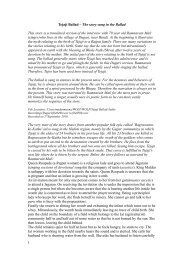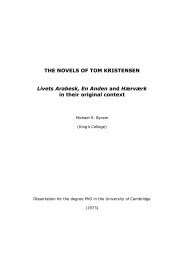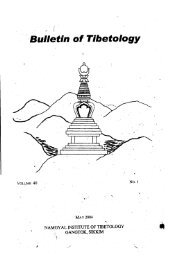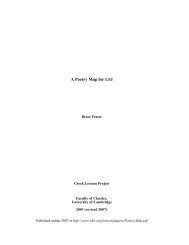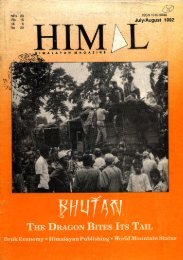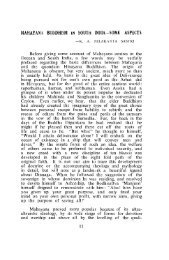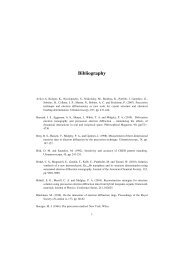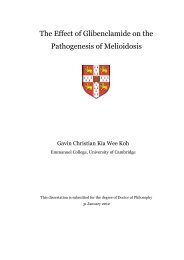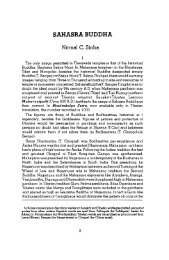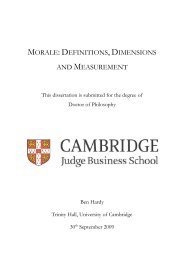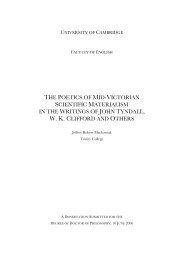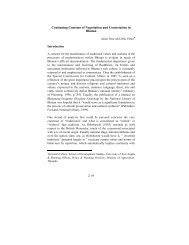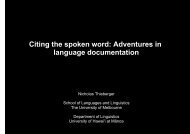The Crusades, the Genoese and the Latin East - DSpace at ...
The Crusades, the Genoese and the Latin East - DSpace at ...
The Crusades, the Genoese and the Latin East - DSpace at ...
Create successful ePaper yourself
Turn your PDF publications into a flip-book with our unique Google optimized e-Paper software.
This paragraph is a conspicuous present<strong>at</strong>ion of <strong>the</strong> <strong>Genoese</strong> commitment to <strong>the</strong> count in<br />
exchange for <strong>the</strong> privileges th<strong>at</strong> he granted <strong>the</strong>m. This charter was h<strong>and</strong>ed to <strong>the</strong> <strong>Genoese</strong> consuls<br />
Lamberto Fornario <strong>and</strong> Belmusto Lercario, who were <strong>the</strong> appointed <strong>Genoese</strong> consuls in <strong>the</strong> <strong>L<strong>at</strong>in</strong><br />
<strong>East</strong> for a period of one year, from <strong>the</strong> autumn of 1203. As will be demonstr<strong>at</strong>ed in Chapter Five,<br />
<strong>the</strong> mission of <strong>the</strong>se <strong>Genoese</strong> consuls represented <strong>the</strong> highest diplom<strong>at</strong>ic level sent from Genoa to<br />
<strong>the</strong> <strong>L<strong>at</strong>in</strong> <strong>East</strong> since <strong>the</strong> time of <strong>the</strong> Third Crusade. Lamberto Fornario was a very experienced<br />
merchant, whose career can be traced as early as 1191, when he was still very young <strong>and</strong> was<br />
required to make his contracts with <strong>the</strong> permission of his fa<strong>the</strong>r. 217<br />
In 1203, however, Lamberto<br />
sailed on <strong>the</strong> Donna to Ultramare. In Lamberto's contract with <strong>the</strong> shipowner from 18 September<br />
1203 he secured ten places on <strong>the</strong> Donna. It was fur<strong>the</strong>r agreed th<strong>at</strong> when <strong>the</strong> ship returned to<br />
Genoa it would be loaded with 100 canter<strong>at</strong>a (contaria / cantaria) of goods sent by him from <strong>the</strong><br />
<strong>L<strong>at</strong>in</strong> <strong>East</strong>. Interestingly, half of <strong>the</strong> freight was to be cotton <strong>and</strong> <strong>the</strong> o<strong>the</strong>r half contained various<br />
o<strong>the</strong>r merch<strong>and</strong>ise (aliis mercibus) 218 Is this an indic<strong>at</strong>ion of <strong>the</strong> Lamberto's plan to purchase<br />
cotton in Aleppo? It is hard to answer this question because notarial evidence reveals th<strong>at</strong> cotton<br />
had been imported from <strong>the</strong> ports of <strong>the</strong> kingdom of Jerusalem long before 1203. Many <strong>Genoese</strong><br />
contracts contain evidence of trade in cotton219 In 1186 <strong>and</strong> 1190, <strong>the</strong>re is a clear reference to<br />
cotton of Ultramare <strong>and</strong> Sicily being purchased in Genoa. 20 David Abulafia argued th<strong>at</strong> `in <strong>the</strong><br />
twelfth century, <strong>the</strong> <strong>Genoese</strong> were still able to export very significant amounts of cotton from<br />
Sicily, <strong>and</strong> it is possible th<strong>at</strong> <strong>at</strong> this stage it was cotton ra<strong>the</strong>r than grain th<strong>at</strong> drew <strong>the</strong>m so<br />
enthusiastically into tre<strong>at</strong>y rel<strong>at</strong>ions with <strong>the</strong> Norman kings of Sicily from 1156 onwards, though<br />
it is generally agreed th<strong>at</strong> <strong>the</strong> quality of Sicilian cotton remained rel<strong>at</strong>ively low. '221 However,<br />
according to Abulafia <strong>the</strong>re was `serious contraction of cotton production in Sicily after about<br />
1200. '222 This shortage of cotton supply might explain some of <strong>the</strong> urgency in <strong>the</strong> agreement with<br />
Bohemond <strong>and</strong> ultim<strong>at</strong>ely with Aleppo. As David Abulafia demonstr<strong>at</strong>ed `it was Egypt, Syria <strong>and</strong><br />
ultim<strong>at</strong>ely India th<strong>at</strong> became <strong>the</strong> major sources for raw cotton. '223 Significantly, Genoa was<br />
oper<strong>at</strong>ing under ano<strong>the</strong>r economic pressure which was <strong>the</strong> loss of access to Constantinople in<br />
1203, a destin<strong>at</strong>ion which previously served as one of Genoa's central economic destin<strong>at</strong>ions.<br />
Maureen Mazzaoui examined <strong>the</strong> Italian cotton industry in this period. Mazzaoui wrote th<strong>at</strong><br />
217 GC, nos. 117,118,119, from 23 January 1191<br />
218 GG, no. 612, from 18 September 1203. See Nilo Calvini, Nuovo glossario medievale Ligure (Genoa,<br />
1984), "cantarius" <strong>and</strong> "contarium", pp. 94,130.<br />
219<br />
Documents from 1182 <strong>and</strong> 1184 do not mention <strong>the</strong> origin of <strong>the</strong> cotton which could have been imported<br />
from Sicily too. See, for example, OS, 1182, cart. 2, p. 8V, 12R, 20V, or OS, 1184, cart. 2 p. 137R.<br />
220 OS, 1186, no. 326; 05,1190, no. 248<br />
221 David Abulafia, `Industrial Products: <strong>the</strong> Middle Ages', in Simonetta Cavaciocchi (ed. ), Prodotti e<br />
techniche d'Oltremare nelle economie europee, secc. XIII XVIII (Florence, 1998), p. 340<br />
2221bid<br />
p. 338.<br />
223<br />
Ibid, p. 340.<br />
72



